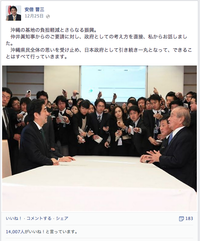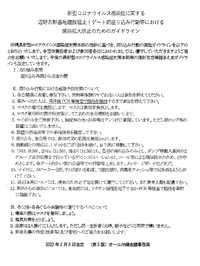2011年02月19日
Network for Okinawa Statement / Press Release #takae
Network for Okinawa Statement/Press Release on New U.S. Military Construction in Yanbaru Forest & Henoko, Okinawa
WASHINGTON – The Japanese Defense Ministry’s Okinawan Headquarters (the Okinawan Defense Bureau) accelerated construction of new facilities at two military bases in northern Okinawa during the last week of January — despite recent signals from U.S. Defense Secretary Robert Gates that the United States would be more flexible in the realignment of bases in Okinawa. The construction prompted calls of protest from international peace and environmental organizations.
Construction workers pushed past local residents to move material and equipment into Takae Village in the Yanbaru Forest. Crews also replaced a barbed wire barrier with a temporary wall on a beach bordering Camp Schwab in an effort to block the view of new construction from protesters. Residents have continuously protested both construction sites since US and Japanese governments announced their plans at the end of 1996; and cite the many sensitive environmental and cultural treasures at risk. Both sites are home to rare and endangered species found only in Okinawa.
“The actions of the Okinawan Defense Bureau are of deep concern and demonstrate the legitimate grievances of the Okinawan community. We urge all parties to exercise firm restraint. We call on the Japanese and American governments to respect the democratic wishes of Okinawans who have overwhelmingly voted to prevent new base construction on Okinawa,” said John Feffer, spokesperson for US-based Network for Okinawa.
Plans for the US Marine Corps’ jungle training area near Takae Village include six new helipads capable of handling the military’s new V-22 Osprey tiltrotor aircraft. Residents object that the construction will surround their village of 160 people and damage the biodiverse Yambaru Forest. Takae’s local residents successfully prevented construction from 2007 until December 2010 when a protest camp was partially destroyed by a US helicopter and construction crews forcibly restarted construction work.
Residents near Camp Schwab oppose construction of a new airbase and military port over coral reefs in Henoko Bay. Military leaders cite this new megabase as a replacement for the existing controversial Futenma airbase in central Okinawa. The plan has drawn international criticism because of the endangered species that live within the construction area. In 2008, a U.S. District Court judge ruled that the U.S. Department of Defense had violated the National Historic Preservation Act (NHPA) by failing to “take into account” in the planning of the construction of a US military base in Henoko and Oura Bay the effects of the construction on the Okinawa dugong, a Japanese “natural monument.” Last November, Okinawa elected a governor who campaigned on the promise to close Futenma and relocate it outside the prefecture.
“It is an incredible tragedy the Japanese and American governments insist on pushing forward with a construction plan that would cause irreparable damage to one of the world’s most diverse biosystems,” said Mr. Feffer. “During a time of economic crisis and mounting deficits, it is shocking that both countries have embraced a plan that cuts education and social welfare programs while supporting a construction plan that benefits only the military-industrial complex.”
The Network for Okinawa (NO) is a grassroots coalition of peace groups, environmental organizations, faith-based organizations, academia, and think tanks, which oppose additional military construction in Okinawa and support the democratic decisions of the people of Okinawa.
NO's official website is http://www.closethebase.org/
February 16, 2011
Construction Accelerates at Two U.S. Military Sites in Okinawa Prefecture
Advocates Express Concern for Treatment of Peaceful Protesters
Advocates Express Concern for Treatment of Peaceful Protesters
WASHINGTON – The Japanese Defense Ministry’s Okinawan Headquarters (the Okinawan Defense Bureau) accelerated construction of new facilities at two military bases in northern Okinawa during the last week of January — despite recent signals from U.S. Defense Secretary Robert Gates that the United States would be more flexible in the realignment of bases in Okinawa. The construction prompted calls of protest from international peace and environmental organizations.
Construction workers pushed past local residents to move material and equipment into Takae Village in the Yanbaru Forest. Crews also replaced a barbed wire barrier with a temporary wall on a beach bordering Camp Schwab in an effort to block the view of new construction from protesters. Residents have continuously protested both construction sites since US and Japanese governments announced their plans at the end of 1996; and cite the many sensitive environmental and cultural treasures at risk. Both sites are home to rare and endangered species found only in Okinawa.
“The actions of the Okinawan Defense Bureau are of deep concern and demonstrate the legitimate grievances of the Okinawan community. We urge all parties to exercise firm restraint. We call on the Japanese and American governments to respect the democratic wishes of Okinawans who have overwhelmingly voted to prevent new base construction on Okinawa,” said John Feffer, spokesperson for US-based Network for Okinawa.
Plans for the US Marine Corps’ jungle training area near Takae Village include six new helipads capable of handling the military’s new V-22 Osprey tiltrotor aircraft. Residents object that the construction will surround their village of 160 people and damage the biodiverse Yambaru Forest. Takae’s local residents successfully prevented construction from 2007 until December 2010 when a protest camp was partially destroyed by a US helicopter and construction crews forcibly restarted construction work.
Residents near Camp Schwab oppose construction of a new airbase and military port over coral reefs in Henoko Bay. Military leaders cite this new megabase as a replacement for the existing controversial Futenma airbase in central Okinawa. The plan has drawn international criticism because of the endangered species that live within the construction area. In 2008, a U.S. District Court judge ruled that the U.S. Department of Defense had violated the National Historic Preservation Act (NHPA) by failing to “take into account” in the planning of the construction of a US military base in Henoko and Oura Bay the effects of the construction on the Okinawa dugong, a Japanese “natural monument.” Last November, Okinawa elected a governor who campaigned on the promise to close Futenma and relocate it outside the prefecture.
“It is an incredible tragedy the Japanese and American governments insist on pushing forward with a construction plan that would cause irreparable damage to one of the world’s most diverse biosystems,” said Mr. Feffer. “During a time of economic crisis and mounting deficits, it is shocking that both countries have embraced a plan that cuts education and social welfare programs while supporting a construction plan that benefits only the military-industrial complex.”
The Network for Okinawa (NO) is a grassroots coalition of peace groups, environmental organizations, faith-based organizations, academia, and think tanks, which oppose additional military construction in Okinawa and support the democratic decisions of the people of Okinawa.
NO's official website is http://www.closethebase.org/
Posted by n_n at 10:43
│記事







